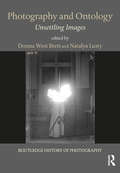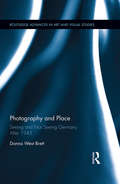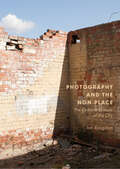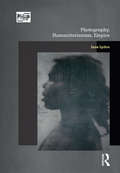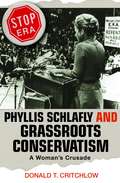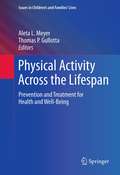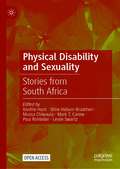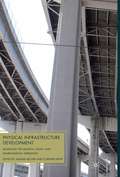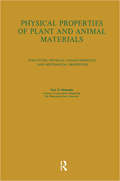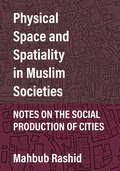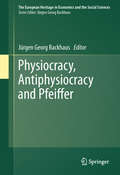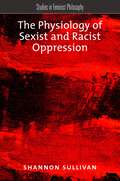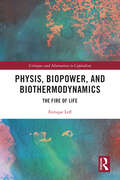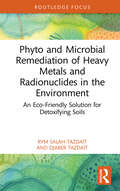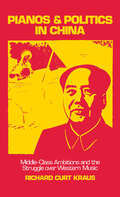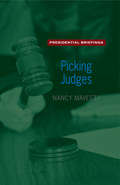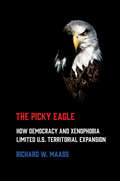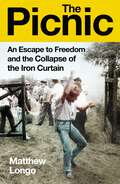- Table View
- List View
Photography and Ontology: Unsettling Images (Routledge History of Photography)
by Donna West Brett Natalya LustyThis edited collection explores the complex ways in which photography is used and interpreted: as a record of evidence, as a form of communication, as a means of social and political provocation, as a mode of surveillance, as a narrative of the self, and as an art form. What makes photographic images unsettling and how do the re-uses and interpretations of photographic images unsettle the self-evident reality of the visual field? Taking up these themes, this book examines the role of photography as a revelatory medium underscored by its complex association with history, memory, experience and identity.
Photography and Place: Seeing and Not Seeing Germany After 1945 (Routledge Advances in Art and Visual Studies)
by Donna West BrettAs a recording device, photography plays a unique role in how we remember places and events that happened there. This includes recording events as they happen, or recording places where something occurred before the photograph was taken, commonly referred to as aftermath photography. This book presents a theoretical and historical analysis of German photography of place after 1945. It analyses how major historical ruptures in twentieth-century Germany and associated places of trauma, memory and history affected the visual field and the circumstances of looking. These ruptures are used to generate a new reading of postwar German photography of place. The analysis includes original research on world-renowned German photographers such as Thomas Struth, Thomas Demand, Michael Schmidt, Boris Becker and Thomas Ruff as well as photographers largely unknown in the Anglophone world.
Photography and Place: Seeing and Not Seeing Germany After 1945 (Routledge Advances in Art and Visual Studies)
by Donna West BrettAs a recording device, photography plays a unique role in how we remember places and events that happened there. This includes recording events as they happen, or recording places where something occurred before the photograph was taken, commonly referred to as aftermath photography. This book presents a theoretical and historical analysis of German photography of place after 1945. It analyses how major historical ruptures in twentieth-century Germany and associated places of trauma, memory and history affected the visual field and the circumstances of looking. These ruptures are used to generate a new reading of postwar German photography of place. The analysis includes original research on world-renowned German photographers such as Thomas Struth, Thomas Demand, Michael Schmidt, Boris Becker and Thomas Ruff as well as photographers largely unknown in the Anglophone world.
Photography and the Non-Place: The Cultural Erasure of the City
by Jim BrogdenThis book presents a critical and aesthetic defence of “non-place” as an act of cultural reclamation. Through the restorative properties of photography, it re-conceptualises the cultural significance of non-place. The non-place is often referred to as “wasteland”, and is usually avoided. The sites investigated in this book are located where access and ownership are often ambiguous or in dispute; they are places of cultural forgetting. Drawing on the author’s own photographic research-led practice, as well as material from photographers such as Ed Ruscha, Joel Sternfeld and Richard Misrach, this study employs a deliberately allusive intertexuality to offer a unique insight into the contested notions surrounding landscape representation. Ultimately, it argues that the non-place has the potential to reveal a version of England that raises questions about identity, loss, memory, landscape valorisation, and, perhaps most importantly, how we are to arrive at a more meaningful place.
Photography, Humanitarianism, Empire (Photography, History: History, Photography)
by Jane LydonWith their power to create a sense of proximity and empathy, photographs have long been a crucial means of exchanging ideas between people across the globe; this book explores the role of photography in shaping ideas about race and difference from the 1840s to the 1948 Declaration of Human Rights. Focusing on Australian experience in a global context, a rich selection of case studies – drawing on a range of visual genres, from portraiture to ethnographic to scientific photographs – show how photographic encounters between Aboriginals, missionaries, scientists, photographers and writers fuelled international debates about morality, law, politics and human rights.Drawing on new archival research, Photography, Humanitarianism, Empire is essential reading for students and scholars of race, visuality and the histories of empire and human rights.
Photography, Humanitarianism, Empire (Photography, History: History, Photography)
by Jane LydonWith their power to create a sense of proximity and empathy, photographs have long been a crucial means of exchanging ideas between people across the globe; this book explores the role of photography in shaping ideas about race and difference from the 1840s to the 1948 Declaration of Human Rights. Focusing on Australian experience in a global context, a rich selection of case studies – drawing on a range of visual genres, from portraiture to ethnographic to scientific photographs – show how photographic encounters between Aboriginals, missionaries, scientists, photographers and writers fuelled international debates about morality, law, politics and human rights.Drawing on new archival research, Photography, Humanitarianism, Empire is essential reading for students and scholars of race, visuality and the histories of empire and human rights.
Phyllis Schlafly and Grassroots Conservatism: A Woman's Crusade (PDF) (Politics and Society in Modern America)
by Donald T. CritchlowLongtime activist, author, and antifeminist leader Phyllis Schlafly is for many the symbol of the conservative movement in America. In this provocative new book, historian Donald T. Critchlow sheds new light on Schlafly's life and on the unappreciated role her grassroots activism played in transforming America's political landscape. Based on exclusive and unrestricted access to Schlafly's papers as well as sixty other archival collections, the book reveals for the first time the inside story of this Missouri-born mother of six who became one of the most controversial forces in modern political history. It takes us from Schlafly's political beginnings in the Republican Right after the World War II through her years as an anticommunist crusader to her more recent efforts to thwart same-sex marriage and stem the flow of illegal immigrants. Schlafly's political career took off after her book A Choice Not an Echo helped secure Barry Goldwater's nomination. With sales of more than 3 million copies, the book established her as a national voice within the conservative movement. But it was Schlafly's bid to defeat the Equal Rights Amendment that gained her a grassroots following. Her anti-ERA crusade attracted hundreds of thousands of women into the conservative fold and earned her a name as feminism's most ardent opponent. In the 1970s, Schlafly founded the Eagle Forum, a Washington-based conservative policy organization that today claims a membership of 50,000 women. Filled with fresh insights into these and other initiatives, Phyllis Schlafly and Grassroots Conservatism provides a telling profile of one of the most influential activists in recent history. Sure to invite spirited debate, it casts new light on a major shift in American politics, the emergence of the Republican Right.
Physical Activity Across the Lifespan: Prevention and Treatment for Health and Well-Being (Issues in Children's and Families' Lives #12)
by Aleta L. Meyer and Thomas P. GullottaThe statistics are disturbing: steadily rising numbers of sedentary overweight children and obese teens, and a generation looking at a shorter life expectancy than their parents’. But while it may be obvious that physical fitness benefits both the mind and body, a growing research base is supplying evidence of why this is so, and how these benefits may be reproduced in greater numbers.Physical Activity Across the Lifespan makes a clear, scientific case for exercise, sports, and an active lifestyle in preventing illness and establishing lifetime health habits at both the individual and the population levels. The book focuses on key aspects of physical/mental well-being—weight, mood, and self-regulation—and the role of physical activity in public health and school-based interventions targeting these areas. Contributors review definitional and measurement issues salient to understanding what physical activity is, to analyzing benefits of participation, and to implementing effective interventions. Also addressed are limitations of current research, steps needed to continue building the field, and emerging therapeutic possibilities for activity, such as the role of rough and tumble play in preventing ADHD. Included in the coverage:Physical activity, cognition, and school performance.The influence of social and built environments on physical activity in middle-aged and older adults.Preventing and treating obesity through physical activity.Physical activity in preventing drug use and treating chemical dependence.Antidepressant properties of physical activity.Schools as a foundation for physical activity and an active lifestyle.Physical activity as an adjunct or booster to existing interventions.Physical Activity Across the Lifespan is an innovative text for researchers and practitioners in various disciplines including health promotion/disease prevention, child and school psychology, education, health psychology, and public health, as well as program developers and policymakers in these areas.
Physical Disability and Sexuality: Stories from South Africa
by Leslie Swartz Poul Rohleder Xanthe Hunt Stine Hellum Braathen Mussa Chiwaula Mark T. CarewThis open access edited volume explores physical disability and sexuality in South Africa, drawing on past studies, new research conducted by the editors, and first-person narratives from people with physical disabilities in the country. Sexuality has long been a site of oppression and discrimination for people with disabilities based on myths and misconceptions, and this book explores how these play out for people with physical disabilities in the South African setting. One myth with which the book is centrally concerned, is that people with disabilities are unable to have sex, or are seen as lacking sexuality by society at large. Societal understandings of masculinity, femininity, bodies and attractiveness, often lead people with physical disabilities to be seen as being undesirable romantic or sexual partners. The contributions in this volume explore how these prevailing social conditions impact on the access to sexual and reproductive healthcare, involvement in romantic relationships, childbearing, and sexual citizenship as a whole, of people with physical disabilities in the Western Cape of the country. The authors' research, and first person contributions by people with physical disabilities themselves, suggest that education and public health policy must change, if the sexual and reproductive health rights and full inclusion of people with disabilities are to be achieved.
Physical Infrastructure Development: Balancing the Growth, Equity, and Environmental Imperatives
by W. Ascher C. KruppThis book addresses the key challenges of balancing economic growth, poverty alleviation, and environmental protection in the development of major physical infrastructure, ranging from transport to energy.
Physical Properties of Plant and Animal Materials: v. 1: Physical Characteristics and Mechanical Properties
by Nuri N. MohseninThis collection of essays by both Western and East European experts examines the efforts to develop strategies for dealing with the environmental crisis both by governments and at the grassroots level of newly emerging green movements.
Physical Space and Spatiality in Muslim Societies: Notes on the Social Production of Cities
by Mahbub RashidMahbub Rashid embarks on a fascinating journey through urban space in all of its physical and social aspects, using the theories of Foucault, Bourdieu, Lefebvre, and others to explore how consumer capitalism, colonialism, and power disparity consciously shape cities. Using two Muslim cities as case studies, Algiers (Ottoman/French) and Zanzibar (Ottoman/British), Rashid shows how Western perceptions can only view Muslim cities through the lens of colonization—a lens that distorts both physical and social space. Is it possible, he asks, to find a useable urban past in a timeline broken by colonization? He concludes that political economy may be less relevant in premodern cities, that local variation is central to the understanding of power, that cities engage more actively in social reproduction than in production, that the manipulation of space is the exercise of power, that all urban space is a conscious construct and is therefore not inevitable, and that consumer capitalism is taking over everyday life. Ultimately, we reconstruct a present from a fragmented past through local struggles against the homogenizing power of abstract space.
Physiocracy, Antiphysiocracy and Pfeiffer (The European Heritage in Economics and the Social Sciences #10)
by Jürgen Georg Georg BackhausPhysiocracy, or the economic theory that a nation’s wealth comes from is agricultural and land development, was a popular school of thought in France in the 18th century. The contribution and significance of the Physiocrats and Antiphysiocrats are explored in detail through chapter contributions by economists, philosophers, and social historians. The book concludes that neither the Physiocrats, nor the Antiphysiocrats were pure profit maximizers and that they all had the well-being of the commonwealth in mind. It brings to light previous studies only conducted in German and is the first analysis of Pfeiffer in a century, making the book of interest to any student or scholar of political economy and the history of economic thought. The contribution and significance of the Physiocrats and Antiphysiocrats are explored in detail through chapter contributions by economists, philosophers, and social historians. It brings to light previous studies only conducted in German and is the first analysis of Pfeiffer in a century, making the book of interest to any student or scholar of political economy and the history of economic thought.
The Physiology of Sexist and Racist Oppression (Studies in Feminist Philosophy)
by Shannon SullivanWhile gender and race often are considered socially constructed, this book argues that they are physiologically constituted through the biopsychosocial effects of sexism and racism. This means that to be fully successful, critical philosophy of race and feminist philosophy need to examine not only the financial, legal, political and other forms of racist and sexism oppression, but also their physiological operations. Examining a complex tangle of affects, emotions, knowledge, and privilege, The Physiology of Sexist and Racist Oppression develops an understanding of the human body whose unconscious habits are biological. On this account, affect and emotion are thoroughly somatic, not something "mental" or extra-biological layered on top of the body. They also are interpersonal, social, and can be transactionally transmitted between people. Ranging from the stomach and the gut to the hips and the heart, from autoimmune diseases to epigenetic markers, Sullivan demonstrates the gastrointestinal effects of sexual abuse that disproportionately affect women, often manifesting as IBS, Crohn's disease, or similar functional disorders. She also explores the transgenerational effects of racism via epigenetic changes in African American women, who experience much higher pre-term birth rates than white women do, and she reveals the unjust benefits for heart health experienced by white people as a result of their racial privilege. Finally, developing the notion of a physiological therapy that doesn't prioritize bringing unconscious habits to conscious awareness, Sullivan closes with a double-barreled approach for both working for institutional change and transforming biologically unconscious habits. The Physiology of Sexist and Racist Oppression skillfully combines feminist and critical philosophy of race with the biological and health sciences. The result is a critical physiology of race and gender that offers new strategies for fighting male and white privilege.
PHYSIOLOGY SEXIST & RACIST OPPRESS SFP C (Studies in Feminist Philosophy)
by Shannon SullivanWhile gender and race often are considered socially constructed, this book argues that they are physiologically constituted through the biopsychosocial effects of sexism and racism. This means that to be fully successful, critical philosophy of race and feminist philosophy need to examine not only the financial, legal, political and other forms of racist and sexism oppression, but also their physiological operations. Examining a complex tangle of affects, emotions, knowledge, and privilege, The Physiology of Sexist and Racist Oppression develops an understanding of the human body whose unconscious habits are biological. On this account, affect and emotion are thoroughly somatic, not something "mental" or extra-biological layered on top of the body. They also are interpersonal, social, and can be transactionally transmitted between people. Ranging from the stomach and the gut to the hips and the heart, from autoimmune diseases to epigenetic markers, Sullivan demonstrates the gastrointestinal effects of sexual abuse that disproportionately affect women, often manifesting as IBS, Crohn's disease, or similar functional disorders. She also explores the transgenerational effects of racism via epigenetic changes in African American women, who experience much higher pre-term birth rates than white women do, and she reveals the unjust benefits for heart health experienced by white people as a result of their racial privilege. Finally, developing the notion of a physiological therapy that doesn't prioritize bringing unconscious habits to conscious awareness, Sullivan closes with a double-barreled approach for both working for institutional change and transforming biologically unconscious habits. The Physiology of Sexist and Racist Oppression skillfully combines feminist and critical philosophy of race with the biological and health sciences. The result is a critical physiology of race and gender that offers new strategies for fighting male and white privilege.
Physis, Biopower, and Biothermodynamics: The Fire of Life (ISSN)
by Enrique LeffBuilding upon the idea that our current "environmental question" arises from the history of metaphysics—which privileged thought about Being (or ontology) over the conditions of life—this book reinterprets Heraclitus’s notion of physis as the fundamental, emergent potency of life, as the category to-be-thought by thinkers. In so doing, it deconstructs the interpretation offered by Heidegger and so stresses the struggle between the creative force of life and its subjection to the human Logos or "meaning". Physis, understood as the pre-ontological potentiality of life itself, thus becomes the cornerstone of a materialist philosophy of life.Following engagements with the work of Nietzsche, Foucault, and Janicaud to explore the significance of human intervention into the realm of life via the "will to power", "biopower" and the "power of rationality" respectively, the author explores twentieth-century rearticulations of the concept of physis through a range of developments in biothermodynamics, thus grounding a new philosophy of life and a new bioeconomics in a revisited biothermodynamics centered on the concept of negentropy.An extensive engagement with the history and development of thought about the generative force of life on Earth, Physis, Biopower, Biothermodynamics, and Bioeconomics: The Fire of Life will appeal to scholars of philosophy, social theory, and political theory with interests in environmental thought, political ecology, and questions of sustainability.
Physis, Biopower, and Biothermodynamics: The Fire of Life (ISSN)
by Enrique LeffBuilding upon the idea that our current "environmental question" arises from the history of metaphysics—which privileged thought about Being (or ontology) over the conditions of life—this book reinterprets Heraclitus’s notion of physis as the fundamental, emergent potency of life, as the category to-be-thought by thinkers. In so doing, it deconstructs the interpretation offered by Heidegger and so stresses the struggle between the creative force of life and its subjection to the human Logos or "meaning". Physis, understood as the pre-ontological potentiality of life itself, thus becomes the cornerstone of a materialist philosophy of life.Following engagements with the work of Nietzsche, Foucault, and Janicaud to explore the significance of human intervention into the realm of life via the "will to power", "biopower" and the "power of rationality" respectively, the author explores twentieth-century rearticulations of the concept of physis through a range of developments in biothermodynamics, thus grounding a new philosophy of life and a new bioeconomics in a revisited biothermodynamics centered on the concept of negentropy.An extensive engagement with the history and development of thought about the generative force of life on Earth, Physis, Biopower, Biothermodynamics, and Bioeconomics: The Fire of Life will appeal to scholars of philosophy, social theory, and political theory with interests in environmental thought, political ecology, and questions of sustainability.
Phyto and Microbial Remediation of Heavy Metals and Radionuclides in the Environment: An Eco-Friendly Solution for Detoxifying Soils (Routledge Focus on Environment and Sustainability)
by Rym Salah-Tazdaït Djaber TazdaïtThis book examines the role that bioremediation can play in the detoxification of soil, water, and air to improve environmental and human health, with a specific focus on heavy metals and radionuclides. Environmental pollution, whether by natural or human causes, with industrial activities being a key player, is a challenge facing all nations across the world. While treatment has typically required the use of expensive technology, one promising solution is the use of phytoremediation, in which plants act by metabolizing or sequestering pollutants. This eco-friendly solution is a good alternative to the standard methods of soil and water treatments. This book provides not only the basic definitions and classification of technologies used for contaminant remediation but also the most recent studies dealing with the selection of new promising microbial stains and plant varieties involved in the treatment of radioactive and heavy metal contaminants. It provides a detailed description of the biochemical mechanisms and genes involved in the bioremediation of radionuclides and heavy metals, offering a clear insight for academics and practitioners interested in in vitro and in situ biological treatment. This book will be of great value to students and scholars interested in environmental pollution and environmental health from across a range of different disciplines, including environmental microbiology and chemistry, ecology and environmental science, biological and environmental engineering and biotechnology.
Phyto and Microbial Remediation of Heavy Metals and Radionuclides in the Environment: An Eco-Friendly Solution for Detoxifying Soils (Routledge Focus on Environment and Sustainability)
by Rym Salah-Tazdaït Djaber TazdaïtThis book examines the role that bioremediation can play in the detoxification of soil, water, and air to improve environmental and human health, with a specific focus on heavy metals and radionuclides. Environmental pollution, whether by natural or human causes, with industrial activities being a key player, is a challenge facing all nations across the world. While treatment has typically required the use of expensive technology, one promising solution is the use of phytoremediation, in which plants act by metabolizing or sequestering pollutants. This eco-friendly solution is a good alternative to the standard methods of soil and water treatments. This book provides not only the basic definitions and classification of technologies used for contaminant remediation but also the most recent studies dealing with the selection of new promising microbial stains and plant varieties involved in the treatment of radioactive and heavy metal contaminants. It provides a detailed description of the biochemical mechanisms and genes involved in the bioremediation of radionuclides and heavy metals, offering a clear insight for academics and practitioners interested in in vitro and in situ biological treatment. This book will be of great value to students and scholars interested in environmental pollution and environmental health from across a range of different disciplines, including environmental microbiology and chemistry, ecology and environmental science, biological and environmental engineering and biotechnology.
Pianos and Politics in China: Middle-Class Ambitions and the Struggle over Western Music
by Richard Curt KrausIn China, a nation where the worlds of politics and art are closely linked, Western classical music was considered during the cultural revolution to be an imperialist intrusion, in direct conflict with the native aesthetic. In this revealing chronicle of the relationship between music and politics in twentieth-century China, Richard Kraus examines the evolution of China's ever-changing disposition towards European music and demonstrates the steady westernization of Chinese music. Placing China's cultural conflicts in global perspective, he traces the lives of four Chinese musicians and reflects on how their experiences are indicative of China's place at the furthest edge of an expanding Western international order.
Picking Judges
by Nancy MaveetyWhat defines a president? Is it policymaking? A good relationship with the American people? Or is it legacy? Most would argue that legacy imprints a president in the American consciousness. A president's federal judicial appointees may be his or her most lasting political legacy. Because federal judges serve for life, their legal policymaking endures long after a president's term in office is over. Presidents who care about serving their mandate, who desire to maximize their policy agenda, and who wish to influence the nation's constitutional fabric appoint as many federal judges as possible.This new volume in the Presidential Briefings series shows how the president's appointment power has expanded beyond its bare constitutional outlines. In exercising their constitutional powers while paying heed to political opportunities, presidents and the Senate have together created our modern judicial appointment politics. Presidents consider a host of demographic and ideological factors, candidate qualities, and electoral politics.Nancy Maveety examines the dynamics of screening and choosing judicial nominees and analyses the institutional calculus in securing their confirmation in the face of senatorial obstruction. Maveety shows how a president can adapt to particular circumstances and provides an outline for synergistically staffing the federal judiciary, thus securing a legacy for all time.
Picking Judges
by Nancy MaveetyWhat defines a president? Is it policymaking? A good relationship with the American people? Or is it legacy? Most would argue that legacy imprints a president in the American consciousness. A president's federal judicial appointees may be his or her most lasting political legacy. Because federal judges serve for life, their legal policymaking endures long after a president's term in office is over. Presidents who care about serving their mandate, who desire to maximize their policy agenda, and who wish to influence the nation's constitutional fabric appoint as many federal judges as possible.This new volume in the Presidential Briefings series shows how the president's appointment power has expanded beyond its bare constitutional outlines. In exercising their constitutional powers while paying heed to political opportunities, presidents and the Senate have together created our modern judicial appointment politics. Presidents consider a host of demographic and ideological factors, candidate qualities, and electoral politics.Nancy Maveety examines the dynamics of screening and choosing judicial nominees and analyses the institutional calculus in securing their confirmation in the face of senatorial obstruction. Maveety shows how a president can adapt to particular circumstances and provides an outline for synergistically staffing the federal judiciary, thus securing a legacy for all time.
The Picky Eagle: How Democracy and Xenophobia Limited U.S. Territorial Expansion
by Richard W. MaassThe Picky Eagle explains why the United States stopped annexing territory by focusing on annexation's domestic consequences, both political and normative. It describes how the U.S. rejection of further annexations, despite its rising power, set the stage for twentieth-century efforts to outlaw conquest. In contrast to conventional accounts of a nineteenth-century shift from territorial expansion to commercial expansion, Richard W. Maass argues that U.S. ambitions were selective from the start.By presenting twenty-three case studies, Maass examines the decision-making of U.S. leaders facing opportunities to pursue annexation between 1775 and 1898. U.S. presidents, secretaries, and congressmen consistently worried about how absorbing new territories would affect their domestic political influence and their goals for their country. These leaders were particularly sensitive to annexation's domestic costs where xenophobia interacted with their commitment to democracy: rather than grant political representation to a large alien population or subject it to a long-term imperial regime, they regularly avoided both of these perceived bad options by rejecting annexation. As a result, U.S. leaders often declined even profitable opportunities for territorial expansion, and they renounced the practice entirely once no desirable targets remained.In addition to offering an updated history of the foundations of U.S. territorial expansion, The Picky Eagle adds important nuance to previous theories of great-power expansion, with implications for our understanding of U.S. foreign policy and international relations.
The Picnic: An Escape to Freedom and the Collapse of the Iron Curtain
by Matthew LongoA dramatic reconstruction of the greatest border breach in Cold War history and its tumultuous aftermath. 'Evoke[s] the dramatic events in vivid colour . . . fascinating' Katja Hoyer, Telegraph *****'This little gem of a book . . . intensely moving' Sunday Times* A GUARDIAN BIGGEST FICTION AND NON-FICTION FOR 2024 * A WATERSTONES ‘BOOK YOU NEED TO READ IN 2024’ * A FOYLES TOP TEN READ FOR JANUARY 2024 *In August 1989, a group of Hungarian activists did the unthinkable: they entered the forbidden militarised zone of the Iron Curtain - and held a picnic.Word had spread of what was going to happen. On wisps of rumour, thousands of East German 'holiday-makers' had made their way to the border between Hungary and Austria, awaiting an opportunity, fearing prison, surveilled by lurking Stasi agents. The stage was set for the greatest border breach in Cold War history: that day hundreds would cross from the Communist East to the longed-for freedom of the West. The fall of the Berlin Wall, the end of the Soviet Union - the so-called end of history - all would flow from those dramatic hours.Drawing on dozens of original interviews with those involved - activists and border guards, escapees and secret police, as well as the last Communist prime minister of Hungary - Matthew Longo reconstructs this world-shaping event and its tumultuous aftermath. Freedom had been won but parents had been abandoned and families divided. Love affairs faltered and new lives had to be built from scratch.The Picnic is the story of a moment when the tide of history turned. It shows how freedom can be both dream and disillusionment, and how all we take for granted can vanish in an instant.'A pivotal – and exhilarating – moment in late 20th-century history . . . gripping' Observer‘Captivating . . . a vivid, fast-paced narrative’ New York Times
